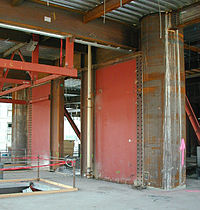
Photo from wikipedia
Abstract According to Chilean design practice, walls usually have complex geometries and discontinuities in height, mainly in the first story. However, the Chilean design code, similar to many design codes,… Click to show full abstract
Abstract According to Chilean design practice, walls usually have complex geometries and discontinuities in height, mainly in the first story. However, the Chilean design code, similar to many design codes, does not provide special provisions for discontinuities. This paper shows the results of an experimental and numerical study of walls with a central opening at the base. Four slender walls are constructed with the same general dimensions, but with different shapes of the opening (15% and 30% of the length, and 11% and 22% of the wall height). The specimens were tested under constant axial load, while cyclic lateral loading is applied at the top. One of the specimens presents slab elements at the base. Results indicate that lateral strength is similar in all cases; however, displacement capacity varies with opening size. All specimens with openings have less ductility, where the specimen with wider and taller opening had a reduced displacement capacity (∼30% reduction). The width of the opening was more influential than the height in the displacement capacity. Numerical analysis was done through a finite element modeling, where one of the models considered all features of the formulation and a second model considered rigid beams placed in all levels forcing the Bernoulli hypothesis (flexural model). Both models can capture strength, stiffness and displacement capacity, and therefore a flexural model can be used for boundary detailing.
Journal Title: Engineering Structures
Year Published: 2019
Link to full text (if available)
Share on Social Media: Sign Up to like & get
recommendations!